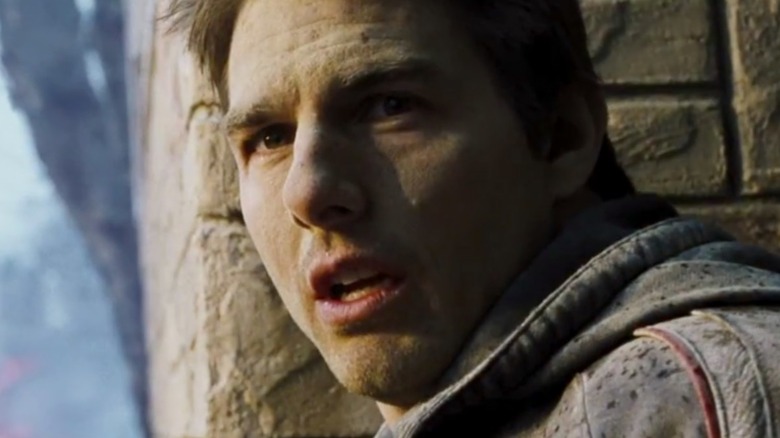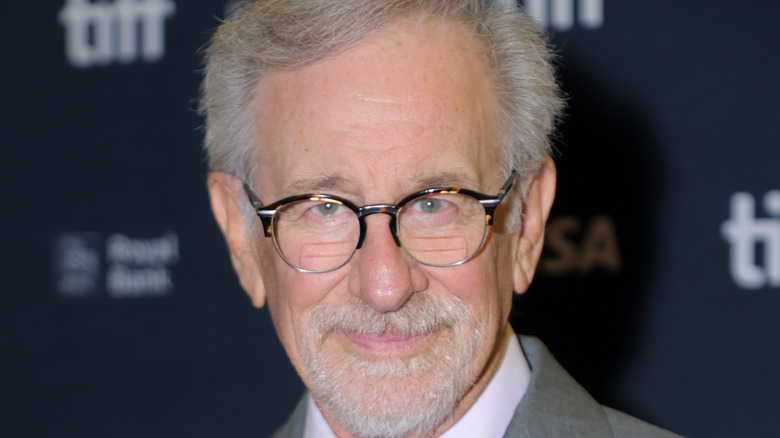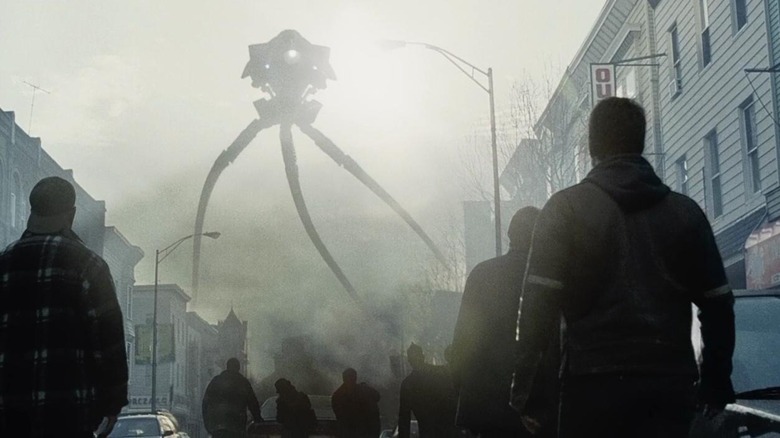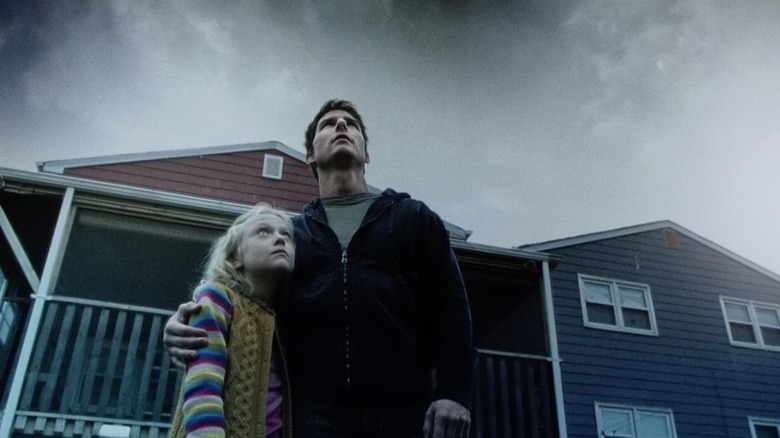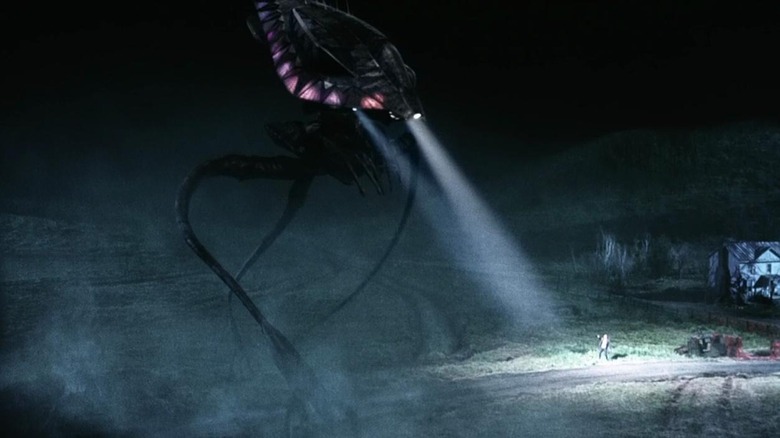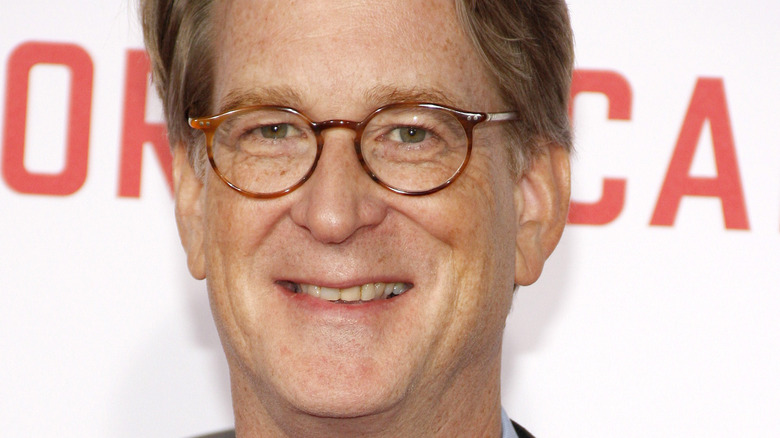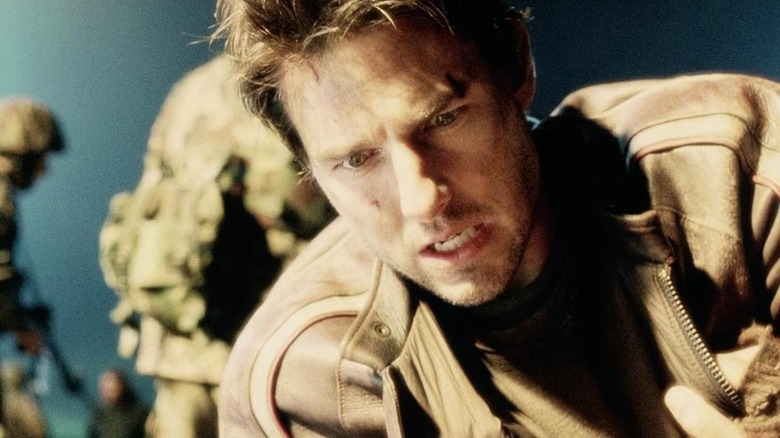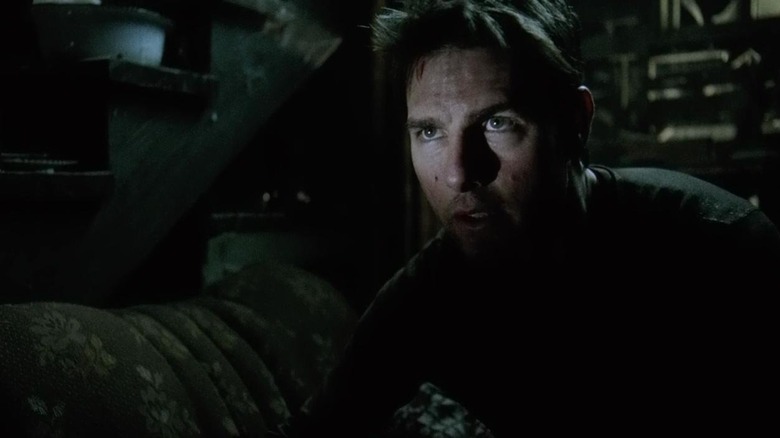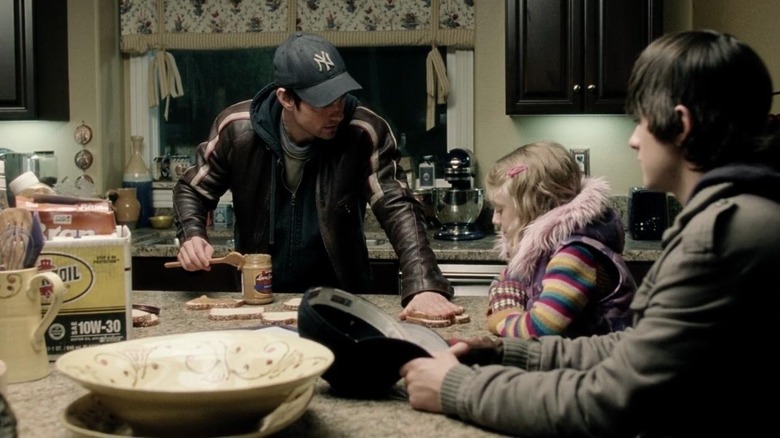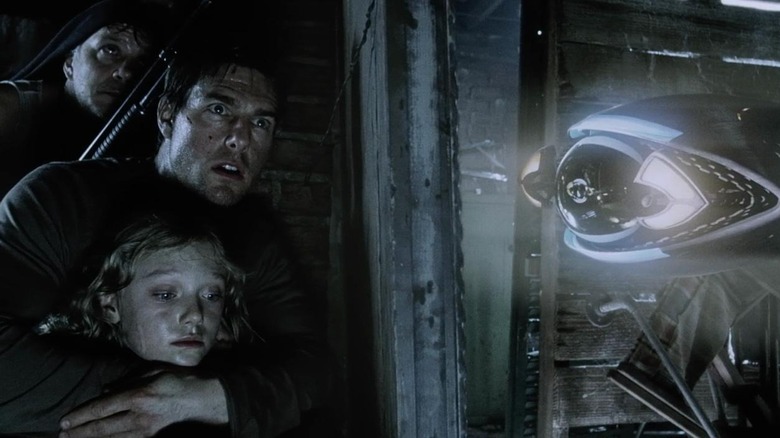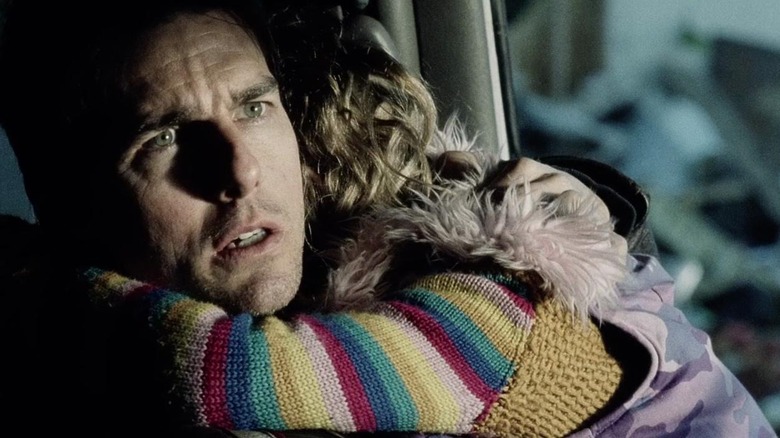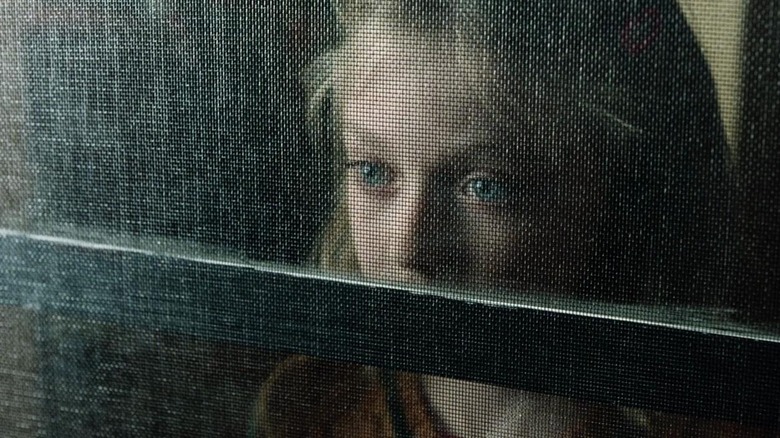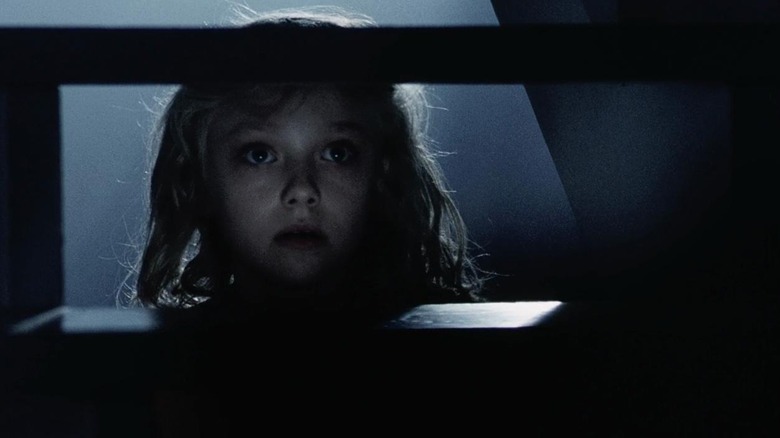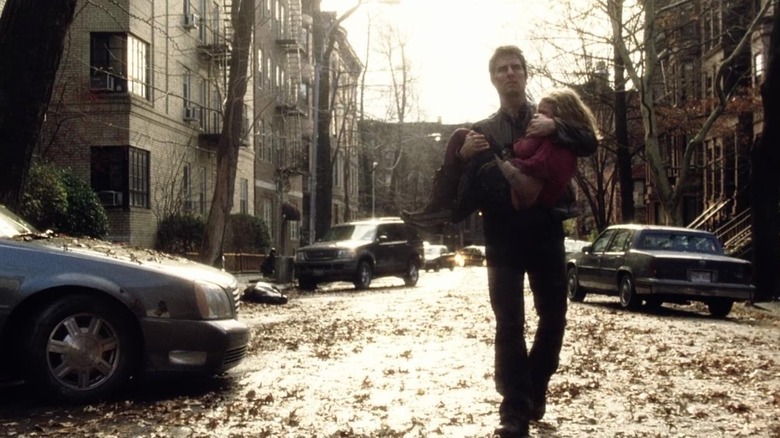13 War Of The Worlds Facts That Will Help Tom Cruise Fans Prepare For The End Of Times
"War of the Worlds" by H.G. Wells was first published in 1897, and since it was first released to the public, this text has proven unspeakably influential on the collective consciousness, especially regarding people's perception and visualization of alien invasions. Further reinterpretations such as the iconic Orson Welles broadcast of "War of the Worlds" have kept this classic story around in some form in the broader pop culture. Its enduring appeal is perfectly encapsulated by the presence of the 2005 Steven Spielberg and Tom Cruise blockbuster, simply titled "War of the Worlds." What other 1897 novels were inspiring massive blockbusters in 2005?
Given its box office success and connection to two extremely well-known artists in the world of cinema, countless people are well aware of this interpretation of "War of the Worlds." But there are many facts about this movie that are still far from common knowledge. Details like the inspiration for the designs of the movies aliens, for instance, or Spielberg's regrets over this blockbuster are just the tip of the iceberg in terms of obscure but no less pivotal facts about this box office sensation. "War of the Worlds" continues to fascinate the public at large just as these details about its 2005 film adaptation will doubtlessly fascinate fans of the feature.
How long Spielberg waited to make War of the Worlds
Steven Spielberg can make movies quickly once he's committed to directing them, but he's also not the kind of guy who just rushes into making a movie the moment he gets enchanted by a certain concept or plot. He's going to wait until all the stars align and he has the resources to realize his full vision. Plus, there can often be extra challenges, such as difficulties with casting or visual effects obstacles, that can make directing these motion pictures a challenging prospect. Projects like "The Adventures of Tintin" or "Lincoln" took decades to realize and "War of the Worlds," as it turns out, was another Spielberg movie that had to wait for just the right moment to exist.
Spielberg explained to the Director's Guild of America that he'd been yearning to do a "War of the Worlds" adaptation for years, but back in 1996, his plans got derailed when he saw "Independence Day." That movie forced Spielberg to reconsider how he'd execute a big-budget alien invasion movie. Returning to the drawing board was a difficult experience for Spielberg, but it eventually led him to figure out that the way to make this "War of the Worlds" adaptation unique was to tell it from the perspective of everyday people. Through waiting and being more measured in how he approached this adaptation, Spielberg tapped into a rich thematic vein that made this "War of the Worlds" adaptation extra enticing to him.
The origins of Spielberg and Cruise doing War of the Worlds
In 2002, Steven Spielberg and Tom Cruise collaborated for their first time ever on "Minority Report." An iconic leading man was acting out the creative vision of an equally iconic filmmaker. This momentous occasion turned out to be so fruitful for both artists that, per their own anecdotes, they immediately began thinking up future projects to collaborate on the moment "Minority Report" was finished.
In contemplating the next Spielberg & Cruise endeavor, the two men looked over a trio of separate concepts. One of them was a modern-day adaptation of "War of the Worlds." Just introducing this concept immediately sparked the imaginations of both Spielberg and Cruise and the duo set out on making it a reality. It's no wonder they sparked to "War of the Worlds" given that, much like "Minority Report," this would be a decidedly modern adaptation of a beloved piece of science-fiction literature.
Earlier abandoned Spielberg movies about dark alien invasions
Part of the marketing push for "War of the Worlds" included emphasizing how this movie was so drastically different from earlier Spielberg movies centering on ordinary humans encountering aliens. These weren't the friendly otherworldly visitors from "Close Encounters of the Third Kind" or "E.T." Instead, "War of the Worlds" concerned brutal aliens who were merciless in their slaughtering of human beings. It was certainly a departure from some of Spielberg's earliest movies, but that doesn't mean Spielberg had never entertained the idea of doing a darker production involving aliens.
Back in the late 1970s, Spielberg had planned to follow up "Close Encounters of the Third Kind" with "Night Skies," a dark horror movie about aliens terrorizing a family that lives on a farm. Despite having a connection to a box office smash like "Third Kind," "Night Skies" never got off the ground, though one of its characters did inspire "E.T." Speaking of that 1982 film, per a breakdown by Birth.Movies.Death (reported on by SlashFilm), a treatment was penned for a sequel to that family-friendly feature that would've involved Elliot and his adolescent chums getting kidnapped by evil aliens who proceed to torture these kids. Neither of these movies involving Spielberg ever got off the ground, but they did hint at the kind of grim alien storytelling he delivered with "War of the Worlds."
What inspired the idea of aliens being buried in the Earth
In the original H.G. Wells novel "War of the Worlds," the alien invaders that devastate Earth come from the planet Mars. It's a classical approach to an extra-terrestrial invasion story, in which the conquering forces come from another planet and wreak havoc on Earthlings. One would imagine, then, that any adaptation of "War of the Worlds" would have to keep this critical part of the original novel. However, in one of many drastic changes from the source material, Spielberg's vision for "War of the Worlds" instead depicts the alien invaders being buried deep within the Earth and emerging only when the time is right to lay waste to humanity.
Entertainment Weekly reported that key creative personnel on the movie offered up different reasons for why this change was incorporated. Steven Spielberg claimed it was done solely because he'd felt there were already so many "War of the Worlds" adaptations featuring alien invaders descending from the heavens. He wanted to provide a new piece of visual language for how this story could be adapted. However, screenwriter David Koepp offered up the reasoning that this change happened to make the plot seem more scientifically realistic. Whatever informed this noticeable change, altering the origins of the alien invasion showed how "War of the Worlds" wasn't slavishly devoted to every aspect of its source material.
How David Koepp approached writing War of the Worlds
Screenwriter David Koepp had already collaborated with Steven Spielberg on multiple occasions before "War of the Worlds" came about, including with the blockbuster movie book adaptation "Jurassic Park." Given their extensive experience with one another, reuniting once again for "War of the Worlds" may have seemed, on paper, like it would be a walk in the park. However, tackling this seminal piece of science-fiction literature came with countless major challenges that Koepp found quite hard to navigate as a screenwriter.
Koepp explained to Empire that the biggest challenge he faced from the get-go on penning "War of the Worlds" was figuring out why this novel needed another big-screen adaptation. The lengthy legacy of "War of the Worlds" movie initially seemed too daunting to overcome, until Koepp zeroed in on the idea of making this version of the story told just from the perspective of one father. Rather than taking a cue from "Independence Day" and other alien invasion movies that focus on an ensemble cast, Koepp's "War of the Worlds" screenplay would have a much more intimate scope. Considering this and other ways "War of the Worlds" could subvert viewer expectations over how an alien invasion movie operates gave Koepp some direction on where to take this adaptation.
The quick pre-production of War of the Worlds
"War of the Worlds" was a massive production, but also one that ran on quite the accelerated production schedule. Notes about the production reveal that Steven Spielberg told producer Kathleen Kennedy from the start that he wanted to start shooting with only a handful of months of prep despite the epic scope of the screenplay. To assuage her fears of pulling this off, Kennedy recalled how Spielberg reminded her that "War of the Worlds" was just about three people, with occasional sequences involving thousands of background players.
While this was a helpful and calming piece of advice, it was still a whirlwind to get "War of the Worlds" ready in the time allotted. The feature's pre-production period was especially crunched, though was made manageable thanks to the crew largely working with Spielberg in the past. This innate familiarity meant people were able to understand Spielberg's vision right away and get "War of the Worlds" running in no time flat. It didn't hurt that Spielberg now had decades of experience under his belt with realizing big-budget action movies full of spectacle and elaborate set pieces. With these factors in play, it quickly becomes apparent how and why "War of the Worlds" was able to get off the ground with such speed.
How 9/11 impacted War of the Worlds
The terrorist attacks of September 11 had an unmistakable impact on the entertainment industry, with movies now having to make sure they were in step with a new societal status quo. There was no going back to the world before 9/11 and motion pictures were going to have to reflect that harsh reality. This also applied to Steven Spielberg's blockbusters, which were often thought of as the ultimate forms of escapist entertainment. However, the filmmaker has been very open that "War of the Worlds" was built from the ground up to be a vision of the alien invasion movie for the post-9/11 era.
Spielberg opened up to USA Today about how 9/11 had altered the emotional ambiance of America, with fear being a much more noticeable part of people's everyday lives. Such rampant terror is present in "War of the Worlds," a movie where evil aliens can pop out from anywhere and devastate humanity. Spielberg opted to filter this relevant atmosphere through everyday people rather than powerful politicians or members of the military. Like so many Americans in the wake of 9/11, the protagonists of "War of the Worlds" are just trying to hold onto their loved ones in the wake of the unthinkable.
How Spielberg saw War of the Worlds fitting into his fixation on broken families
The concept of broken families is a prominent one throughout the works of Steven Spielberg, and he manages to explore this conceit once again when it comes to "War of the Worlds." In a deviation from the storyline of the original H.G. Wells novel, this adaptation of "War of the Worlds" follows a largely absent father who must take care of his two kids when the apocalypse suddenly bears down on the human race.
Spielberg acknowledged to USA Today that his take on "War of the Worlds" was thematically consistent with his prior works, while also noting how the film ran in the opposite direction of "Close Encounters of the Third Kind," his 1977 sci-fi film about a dad who abandons his kids to be with aliens. "I've grown up a lot," Spielberg explained. "I wasn't a dad when I was 27, 28 years old and made that movie. I'm a father now. It's very easy to have somebody leave his family to get on a mother ship when you're not a father yourself." Decades later, Spielberg had become a dad and this meant adjusting the way he navigated broken families in sci-fi films, as seen by the central emotional core of his vision of "War of the Worlds."
Spielberg embraced digital storyboards for War of the Worlds
Steven Spielberg is an old-fashioned guy in many ways. Most notably, he always shoots his movies with 35mm cameras, even as most of the rest of Hollywood has shifted towards capturing motion pictures with digital cameras. However, that doesn't mean Spielberg totally ignores new technological shifts that open up new possibilities for him as a storyteller. Take the world of storyboards for instance. Spielberg has often turned to his paper storyboards in the past as a useful guide for initially executing his creative vision. Though he'd often go in a new direction once the cameras started rolling, those storyboards were still a useful tool to help get his imagination rolling.
Animation World Network revealed that with "War of the Worlds," though, Spielberg upgraded this part of the process to an entirely digital format for the first time. Visual effects supervisor Den Gregoire revealed that the cramped production time on "War of the Worlds" made the use of digital storyboards, which offered more flexibility on what Spielberg could plan for individual shots in advance, a vital tool. These tasks weren't just something delegated to the visual effects team either. Spielberg immersed himself in all kinds of intricate planning using these digital storyboards, a clear sign that this filmmaker was incredibly capable of reveling in exciting new technologies.
The design choices for the film's aliens
The aliens in "War of the Worlds" are not on-screen for much of the movie's runtime, with the creatures instead primarily staying inside their tripods as they decimate humanity. However, they do show up within the final 40 minutes of the feature, with their most prominent appearance coming as part of a suspenseful sequence where it looks like our lead characters will be discovered in the basement of a farm. For this incarnation of the "War of the Worlds" aliens, the visual effects team was very careful about what kind of design they employed for these otherworldly visitors and what kind of real-world inspiration they'd turn to.
A breakdown of the movie's visual effects by Animation World Network revealed that Spielberg got the ball rolling on what the aliens should look like by initially proposing that their appearance take a cue from jellyfish. The animators enjoyed grappling with how these otherworldly creatures would walk on the surface of Earth, with red-eyed tree frogs serving as a basis for their physical behavior. There was also excitement from the animators over how "War of the Worlds" never fully explains who these aliens are, which lent an instantly compelling aura of mystery to their design. Even if they're not explicitly on-screen for much of the movie, there was tons of thought given to the design of the alien invaders of "War of the Worlds."
The biggest challenges John Williams faced in the score
John Williams and Steven Spielberg have been working together for decades now; when you think of one, you think of the other. If a new Spielberg movie is gracing the big screen, chances are, audiences are also going to get a new collection of compositions form John Williams. Given how long they've been working together, one might imagine that Williams would find it as easy to navigate composing music for a new Spielberg movie as it would be to tell what's on the back of his hand. However, a title like "War of the Worlds" presented some unique obstacles for this master composer to navigate.
Williams explained to Gramaphone that "War of the Worlds," as well as fellow 2005 movie "Revenge of the Sith," provided him with the challenge of making sure his music was as bombastic and lively as the images on the screen. With "War of the Worlds," Williams was concerned about making sure his score could measure up to all the Tripods and otherworldly invaders dominating the screen. For another composer, it may have been too tall of an order to come up with a score that could stand out against all that big-screen spectacle. For Williams, though, it was just another job in his longstanding and expansive career working alongside Steven Spielberg.
War of the Worlds and its box office run
2005 was a difficult year for the domestic box office. While individual movies like "Revenge of the Sith" were making money, the marketplace as a whole was down from 2004 and suffering from a deluge of underperforming films. With these financial difficulties, it's no wonder that all eyes turned to "War of the Worlds" as a potential savior for the year's box office. After all, Spielberg and Cruise had shattered box office records before. Perhaps they could inject some of that financial prowess into a year desperately short on hits.
"War of the Worlds" couldn't quite kick out all the box office blahs of 2005, but it still managed to perform quite respectably. The film debuted over the 4th of July weekend, where it scored the second biggest opening in history for a movie opening over that holiday frame (ironically, it only came in behind a movie from 2004, "Spider-Man 2") Its eventual $603.9 million global haul on a $132 million budget was superb and, thanks to a $234 million domestic total, gave Cruise his biggest North American box office performer ever until "Top Gun: Maverick" appeared. Overall for 2005, "War of the Worlds" emerged as the fourth biggest movie of 2005 domestically. Not too shabby of a performance and a much-needed win for the beleaguered 2005 box office.
Spielberg's problems with the War of the Worlds marketing
"War of the Worlds" received generally positive reviews upon its initial release, but it was far from universally beloved. One point of common criticism was the ending, which recreated the conclusion of the original H.G. Wells novel by having the aliens succumb to bacteria exclusive to Earth. It's a subversive ending in theory, but it's easy to see why it rubbed viewers the wrong way. What worked in a novel over 100 years earlier isn't also going to work perfectly in a 2005 blockbuster, especially one that otherwise eschewed core tenets of the original H.G. Wells text up to that point. Even director Steven Spielberg has expressed retrospective regret over this motion picture's conclusion.
In a book entitled "James Cameron's Story of Science Fiction," a conversation between Spielberg and James Cameron is relayed in which the former director admits that "War of the Worlds" didn't have a satisfactory finale. Spielberg goes on to express frustration with how he always struggled throughout the movie's production on how a modern-day "War of the Worlds" should end. Spielberg finally noted that having Morgan Freeman provide closing narration explaining the demise of these aliens was his way of trying to mitigate the problems with this feature's ending. Though it couldn't quite nail its ending, at least "War of the Worlds" was otherwise a generally well-liked foray into darker sci-fi cinema for Spielberg.
